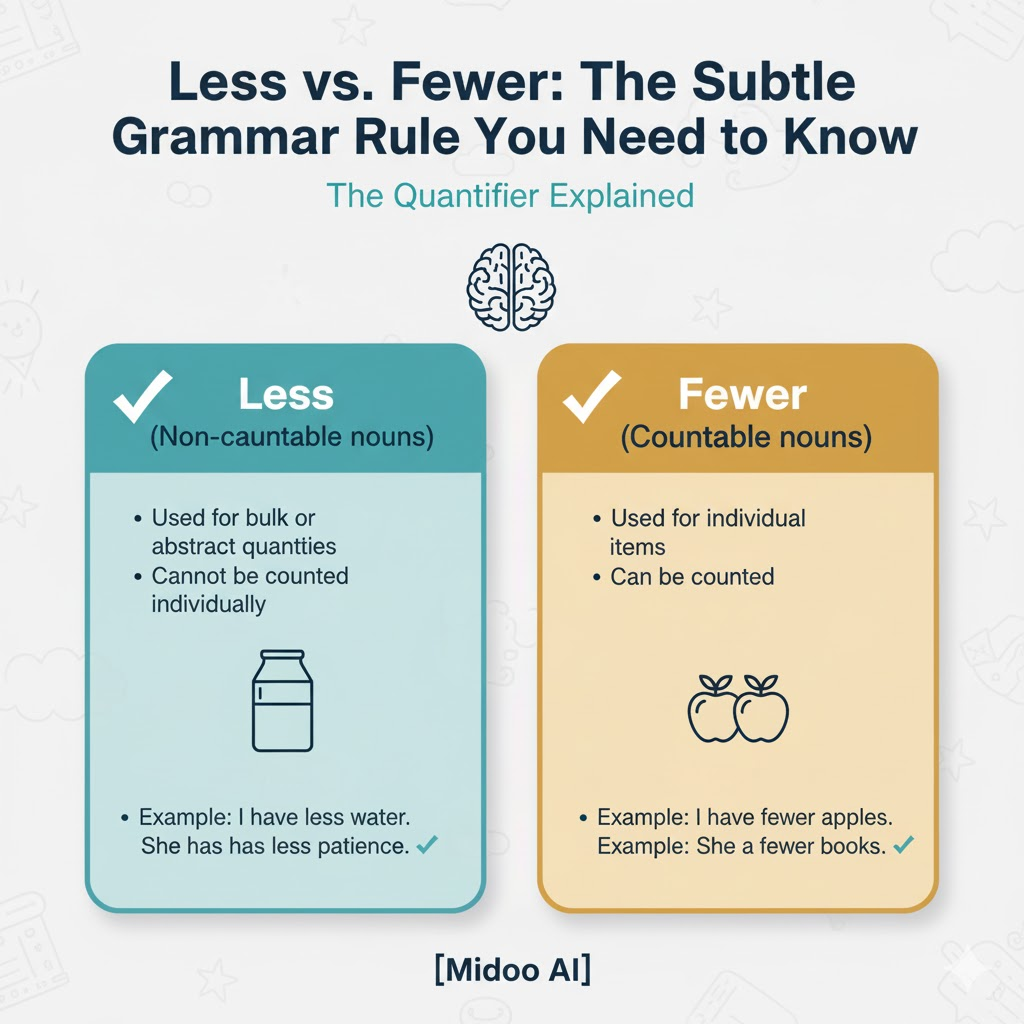Less vs. Fewer: The Subtle Grammar Rule You Need to Know

English learners often get confused between “less” and “fewer.” Both words indicate a smaller amount, yet they follow different grammar rules. At Midoo AI, our learners frequently ask when to use one or the other—especially since even native speakers sometimes mix them up!
In this guide, we’ll break down the rules, show clear examples, and share tips to help you use them correctly every time.
What’s the Difference Between “Less” and “Fewer”?
It all comes down to what can be counted.
- Fewer is used with countable nouns (things you can count one by one).
- Less is used with uncountable nouns (things you measure or see as a total quantity).
Examples:
✅ She has fewer books than I do. → Books can be counted.
✅ He drinks less water than before. → Water is measured, not counted.
💡 Rule of thumb:
If you can count it, use fewer. If you measure it, use less.
Grammar Rule at a Glance
| Type of Noun | Use | Example |
|---|---|---|
| Countable | Fewer | “Fewer people attended the event.” |
| Uncountable | Less | “There’s less noise in the library.” |
Common Mistakes
❌ “10 items or less”
✅ “10 items or fewer”
Although you often see “10 items or less” in supermarkets, “10 items or fewer” is grammatically correct. In casual conversation, “less” may sound smoother, but formal writing should follow the correct rule.
When “Less” Can Be Used with Numbers
There’s an important exception: when talking about measurements—like time, money, distance, or weight—you can use less, even though numbers are involved.
Examples:
✅ “It took less than five minutes.”
✅ “She earns less than $1,000 a month.”
✅ “The beach is less than 2 miles away.”
In these cases, “less” refers to a total amount, not individual countable units.
Real-Life Usage Examples
- Daily speech:
“I’m eating less sugar and fewer cookies.”
→ Sugar = uncountable; cookies = countable. - Business English:
“We had fewer meetings this week but achieved more.” - Academic writing:
“Students who spent less time on social media performed better.”
✍️ Writing Tip from Midoo AI
When you’re unsure, use this simple test:
- If you can say “one, two, three” before the noun → use fewer.
- If you can’t count it → use less.
Example:
- “Cars” → one car, two cars → ✅ fewer cars
- “Traffic” → can’t say one traffic, two traffics → ✅ less traffic
This quick check helps you choose correctly in everyday writing and speech.
How Midoo AI Helps You Master Grammar Naturally
Midoo AI isn’t just a grammar checker—it’s an adaptive English tutor.
When you confuse “less” and “fewer,” Midoo AI instantly explains why, gives corrected examples, and tailors the feedback to your proficiency level.
Instead of memorizing grammar charts, you learn through real-time conversation and correction, just like practicing with a personal teacher.
✅ Quick Recap
| Rule | Use “Fewer” | Use “Less” |
|---|---|---|
| Countable nouns | ✅ “Fewer chairs” | ❌ “Less chairs” |
| Uncountable nouns | ❌ “Fewer milk” | ✅ “Less milk” |
| Time, money, distance | ❌ “Fewer than 10 miles” | ✅ “Less than 10 miles” |
| Informal English | “10 items or less” (accepted) | — |
🧩 FAQs
Q1: Can I say “less people”?
Technically no—“people” is plural and countable, so you should say “fewer people.” However, “less people” is becoming more common in speech, though still considered incorrect in formal English.
Q2: Why do stores say “10 items or less”?
That phrase became popular because it sounds smoother. It’s accepted in casual usage, but grammatically, “10 items or fewer” is correct.
Q3: Is “less” ever correct with countable nouns?
Yes, when expressing totals or measurements (e.g., “less than 5 miles,” “less than 10 dollars”).
Q4: How can I train myself to remember the rule?
Try using Midoo AI’s grammar correction mode, which catches these small but important differences and explains them in context, so you build natural fluency over time.